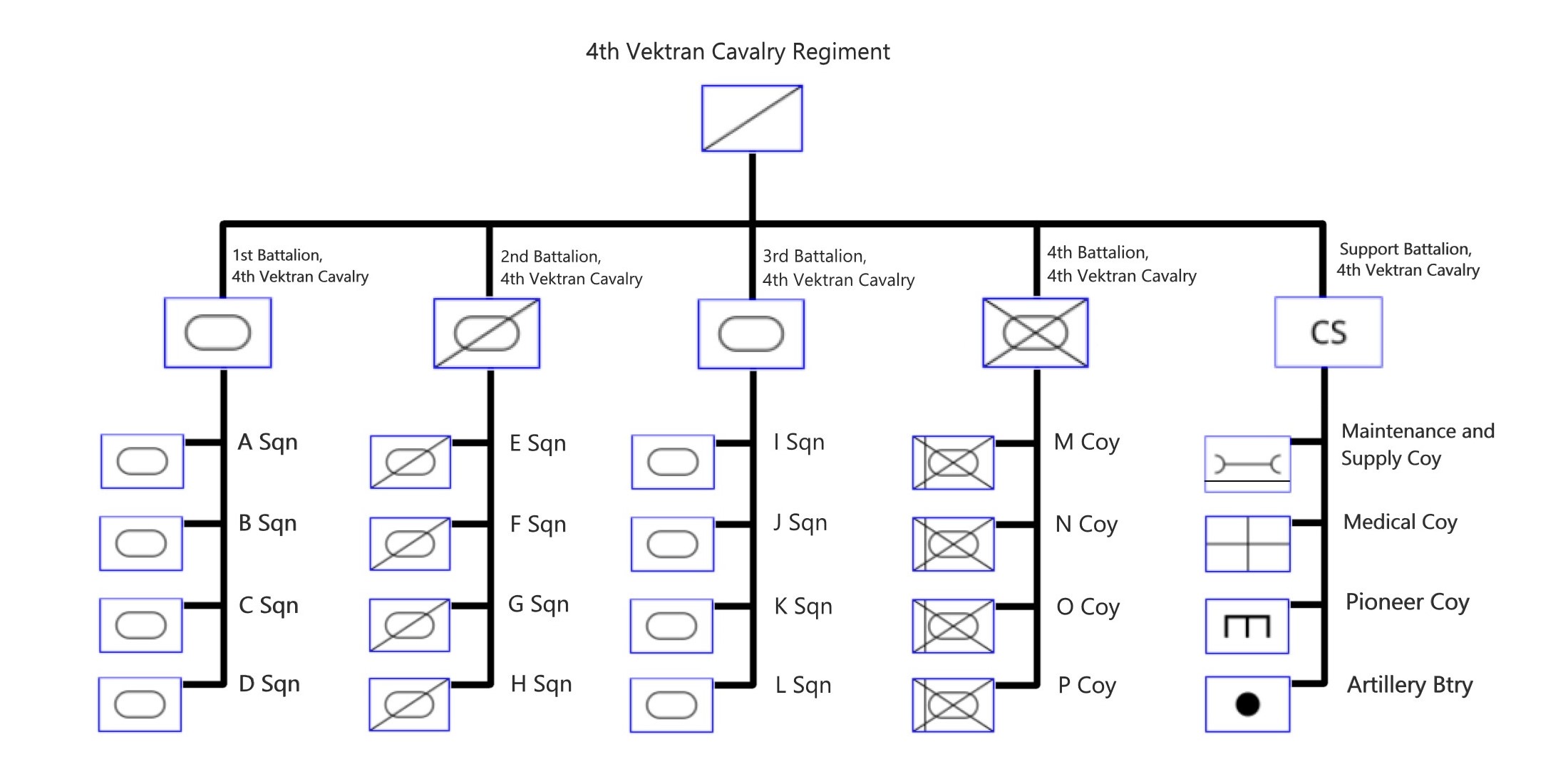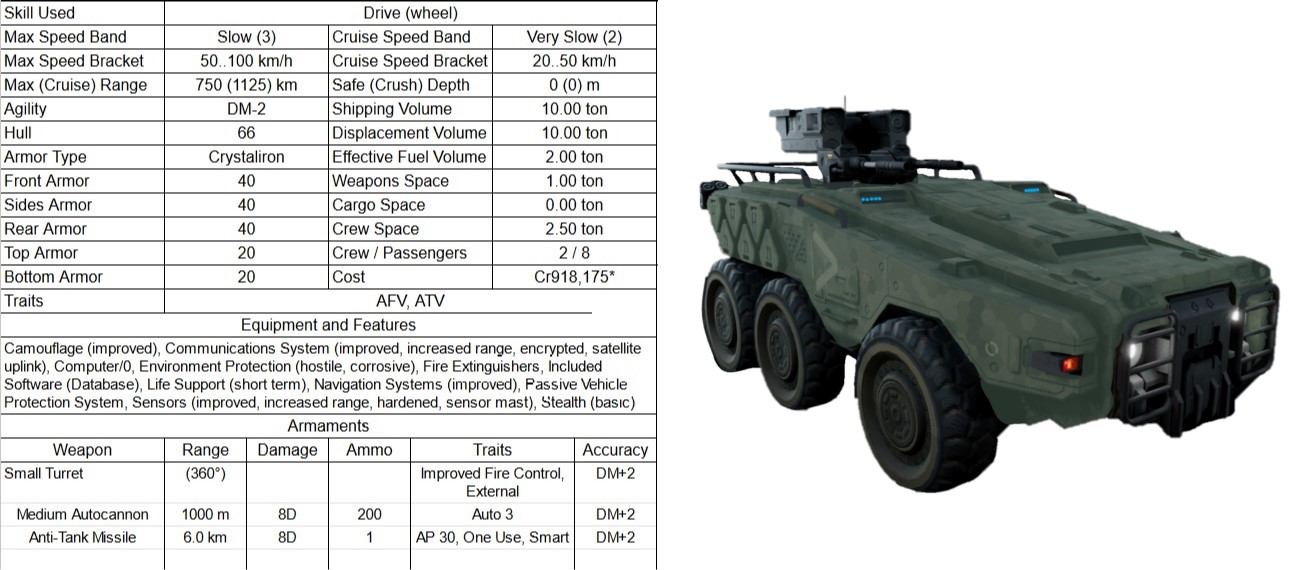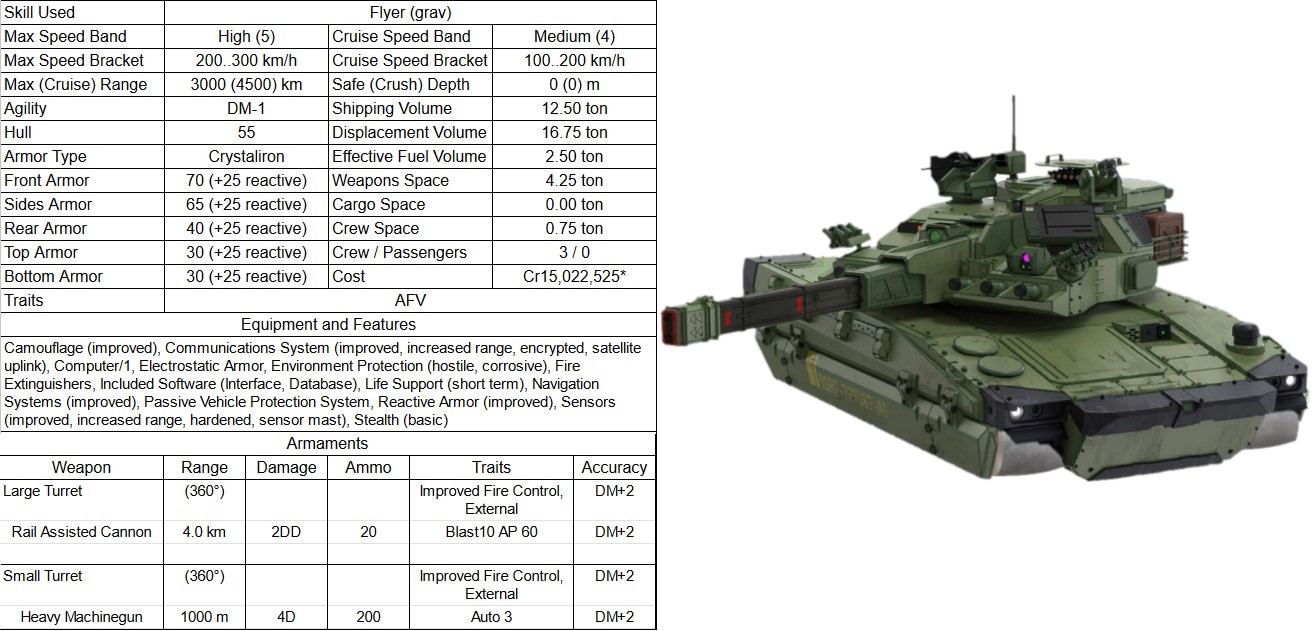Imperial Dominion Army
Structure
The Imperial Army is subdivided into four administrative branches: Infantry, Cavalry, Support, and Commando. The primary function of each branch is to coordinate training and equipment standards across all regiments of the army.
A Division serves as a major combat formation, comprising four or more Brigades. Each Division is numbered and named for clarity, reflecting its place within the broader structure of the Imperial Army. Composition: Each Division consists of:
Each Brigade is a tactical unit made up of two Regiments, providing focused operational capabilities while maintaining flexibility for various mission types. Composition: A Brigade includes:
Infantry Guard Regiments are designed to engage in ground combat with a focus on versatility and adaptability
Cavalry Guard Regiments
Cavalry Guard Regiments leverage armored capabilities to perform rapid maneuvers and support heavy assaults.
Combined Battalion Flexibility: Depending on operational needs, any battalion within these regiments can be combined with elements from different battalion types to create a versatile Combined Battalion. For instance, an armored battalion could integrate reconnaissance and mechanized infantry companies.
Light Battalions are infantry units designed for high mobility and flexibility, typically deployed in lighter vehicles or on foot for rapid maneuvering in various combat scenarios. Each battalion is structured to maintain effective combat power while minimizing logistical footprint, allowing swift response and movement across diverse terrain.
Mechanized Battalions are infantry units equipped with armored personnel carriers (APCs) or infantry fighting vehicles (IFVs) for transport and combat. For logistical simplicity, all companies within a Mechanized Battalion are standardized by vehicle type.
Armored Battalions serve as the primary heavy strike force, utilizing Main Battle Tanks (MBTs) to deliver decisive firepower and maintain dominance over key terrain. Armored units are often positioned to spearhead attacks or provide the backbone of defensive operations. Reconnaissance Battalion
When a regiment is deployed, the Support Battalion establishes a Regimental Support Area (RSA) to sustain front-line units. The RSA coordinates the medical, logistical, repair, engineering and artillery support necessary for prolonged operations through its various companies.
- Infantry Branch: Develops the training and doctrine for infantry, as well as defining requirements and development of body armor, service rifles, machine guns, pistols, canteens, communication systems, etc.—everything the soldier fights with.
- Cavalry Branch: Develops training and doctrine for all Armored Fighting Vehicles (AFVs) and helps define requirements and future developments of AFVs. This includes all subsystems and weapons of these vehicles, as well as any equipment a soldier may need in relation to operating on and with AFVs.
- Support Branch: Develops the training and doctrine for all medical, supply, engineering, artillery, and other supporting troop types, while also defining requirements for these troops' equipment and vehicles.
- Commando Branch: Similar to the other branches but entirely focused on Special Forces.
Divisions and Brigades in the Imperial Army
The Imperial Army is structured into Divisions and Brigades, facilitating coordinated command and deployment of its regimental forces across various operational theaters. Divisional Commanders oversee the strategic deployment of their Brigades, ensuring effective coordination among the Regiments within each Brigade. This organizational structure allows for streamlined command and adaptability in response to evolving battlefield scenarios. Division LevelA Division serves as a major combat formation, comprising four or more Brigades. Each Division is numbered and named for clarity, reflecting its place within the broader structure of the Imperial Army. Composition: Each Division consists of:
- Division Headquarters: Responsible for the overall command and coordination of the Division’s operations.
- Brigades: Typically four or more, each Brigade containing a specific combination of regimental types (Infantry Guard, Cavalry Guard, etc.).
Each Brigade is a tactical unit made up of two Regiments, providing focused operational capabilities while maintaining flexibility for various mission types. Composition: A Brigade includes:
- Brigade Headquarters: Manages the tactical operations and coordination between the Regiments.
- Regiments: Comprised of two Regiments, which can be of the same type (e.g., two Infantry Regiments) or a mix (e.g., one Infantry and one Cavalry Regiment), depending on the Brigade's mission objectives.
Regimental
Combat formations of the imperial army are organized around a planetary regimental system, with 2 types of regiments, Infantry Guard and Cavalry Guard. each regiment being numbered according to what order of battle they are in, for their regimental type, on their home world. meaning you could have 1st infantry, 2nd infantry, 1st Cavalry, 3rd Infantry, etc. on one world, but a different combination on any other world in the Dominion. to avoid potential confusion in large scale military operations, the home world is always included in the name. e.g. 1st Polympian Infantry, 4th Vektran Cavalry, 1st Kassian Infantry etc. Imperial Guard Regiments are always made up of one Regimental Headquarters and Headquarters Company, four Line Battalions and a single Support Battalion. Further doctrine dictates that each regimental type must be made up of a composition for each type of Battalion. The required composition for each type of regiment is as follows: Infantry Guard Regiments- 0-1 Reconnaissance Infantry Guard Battalions
- 1-3 Light Infantry Guard Battalions
- 1-3 Mechanized Infantry Guard Battalions
- 1 Regimental Support Battalion
- 1-2 Reconnaissance Cavalry Guard Battalions
- 2-3 Armored Cavalry Guard Battalions
- 0-1 Mechanized Cavalry Guard Battalions
- 1 Regimental Support Battalion
Infantry Guard Regiments are designed to engage in ground combat with a focus on versatility and adaptability
Cavalry Guard Regiments
Cavalry Guard Regiments leverage armored capabilities to perform rapid maneuvers and support heavy assaults.
Combined Battalion Flexibility: Depending on operational needs, any battalion within these regiments can be combined with elements from different battalion types to create a versatile Combined Battalion. For instance, an armored battalion could integrate reconnaissance and mechanized infantry companies.
Recruitment
All Imperial Regiments recruit on a planetary basis. which means that all members serving in a regiment are planetary residents of the same world. this in turn means that if any member were to move residence to a different world, they would have to be transferred to a different regiment from the new world of recidence. Outside of the planetary restrictions, all the regular requirements of imperial conscription and service applies: Imperial citizenship, minimum 16 years of age, of sound mind and body, height of no lower than 150cm and no higher than 210cm. Cavalry regiments specifically tend to favor members under 190cm in height, due to the limited space inside armored vehicles.Battalions and Sub-Units
Each Line battalion is made up of an HQ platoon and four Companies/Squadrons. In Reconnaissance and Armored Cavalry battalions, a Company sized element is called a squadron. below is more details for each of the individual battalion types and thier respective companies. Light BattalionLight Battalions are infantry units designed for high mobility and flexibility, typically deployed in lighter vehicles or on foot for rapid maneuvering in various combat scenarios. Each battalion is structured to maintain effective combat power while minimizing logistical footprint, allowing swift response and movement across diverse terrain.
Show spoiler
Light Infantry Company
Each Company is made up of 4 Platoons each with a Platoon HQ and 3 Squads, and a Company HQ.
Each Company is made up of 4 Platoons each with a Platoon HQ and 3 Squads, and a Company HQ.
Show spoiler
Motorised Infantry Company
Each Company is made up of 4 Platoons each with a Platoon HQ and 3 Squads mounted in 8 Field Cars, and a Company HQ with 2 APCs.
Each Company is made up of 4 Platoons each with a Platoon HQ and 3 Squads mounted in 8 Field Cars, and a Company HQ with 2 APCs.
Show spoiler
Mechanized Battalion
Jump Infantry Company
Each Company is made up of 4 Platoons each with a Platoon HQ and 3 Squads, and a Company HQ.
Each Company is made up of 4 Platoons each with a Platoon HQ and 3 Squads, and a Company HQ.
Mechanized Battalions are infantry units equipped with armored personnel carriers (APCs) or infantry fighting vehicles (IFVs) for transport and combat. For logistical simplicity, all companies within a Mechanized Battalion are standardized by vehicle type.
Show spoiler
Armored Battalion
Mechanized Infantry Company
Each Company is made up of 4 Platoons each with a Platoon HQ and 3 Squads mounted in 4 APCs, and a Company HQ with 2 APCs.
Each Company is made up of 4 Platoons each with a Platoon HQ and 3 Squads mounted in 4 APCs, and a Company HQ with 2 APCs.
Armored Battalions serve as the primary heavy strike force, utilizing Main Battle Tanks (MBTs) to deliver decisive firepower and maintain dominance over key terrain. Armored units are often positioned to spearhead attacks or provide the backbone of defensive operations. Reconnaissance Battalion
Show spoiler
Regimental Support Battalion
Reconnaissance Company
Each Recon Company is made up of 4 Platoons of 8 Field Cars and a HQ.
Each Recon Company is made up of 4 Platoons of 8 Field Cars and a HQ.
When a regiment is deployed, the Support Battalion establishes a Regimental Support Area (RSA) to sustain front-line units. The RSA coordinates the medical, logistical, repair, engineering and artillery support necessary for prolonged operations through its various companies.
Show spoiler
Maintenance and Supply Company
Show spoiler
Medical Company
Show spoiler
Pioneer Company
Show spoiler
Artillery Battery
Assets
The Imperial Dominion Army is the primary land warfare force of the Dominion, equipped with a comprehensive array of assets to fulfill its operational commitments. The Army’s equipment undergoes periodic updates and modifications to ensure continued effect. these assets includes a range of tanks, vehicles, firearms, armor, and various support equipment for a wide array of combat scenarios.
In the following section, we explore categories of equipment utilized by the Imperial Dominion Army, detailing the capabilities and characteristics of each.
UC91-IFV42 "Crusader" IFV
UC90-EMBT41 "Templar" Tank
L56A3 Machine Gun
Vehicles
APCUC91-IFV42 "Crusader" IFV
UC90-EMBT41 "Templar" Tank
Show spoiler
EXUC90-EMBT41 "G-Templar" Grav Tank
The UC90-EMBT41 "Templar Mk.II". which stands for Universal carrier 9th-series 0-edition, Electromagnetic Main Battle Tank with 4cm cannon, 1st version. though often just referred to as UC90, EMBT41 or Templar. this armoured tracked vehicle comes armed with a turret mounted 4cm Hyper-velocity, Autoloading, Stabilized, Rail Assisted Gun. has a 10 round ready-rack in an ammo cassette in the rear of the turret. while the cassette is stocked the autoloader can reload the cannon every 5 seconds. Once the turret cassette is empty, additional shells stored in the hull of the vehicle would have to be moved into the ammo cassette manually by the crew. This would normally fall on the gunner or commander as the only two crew members in the turret. In the front of the hull there is a 1500 HP engine as well as the Drivers position the hull has a rear ramp for easy evacuation from the vehicle or restocking of ammunition. The turret is equipped with thermal sights, Laser warning receiver, laser rangefinder and a dual-control fire control system. further it has a top mounted remote controlled heavy machine-gun, that combined with the active protection system can provide close in protection, from aerial and ground attacks.
L56A3 Machine Gun
History
Honours
In the Imperial Military it is tradition that regiments keep track of all larger battles and military campaigns they have taken part in, especially the victories. These are collectively known as battle honours, and serve as a way to see each regiments history. following this tradition regiments often adorn regimental regalia, such as banners or crests, with the given names of these battle or campaigns. Many regiments also use their battle honours as a basis for the naming conventions of their companies, but there is no formalized standard since this is based in individual regimental traditions.Honorifics
Certain regiments conduct themselves so honorably and achieve such great fame that they are granted an honorific title. This title is often based on an acceptable pre-existing nickname already in common use within the regiment, a regimental mascot, or a relevant unit type from past eras. Honorific titles are used in combination with the planetary origin of the regiment, ensuring that no two regiments from the same planet have the same honorific title. Furthermore, it is a tradition that there will be no two regiments, regardless of planetary origin, holding the same honorific title. Regimental honorific titles are difficult to earn, making it unnecessary to codify this tradition formally. All regimental honorific titles must be plural, as they are granted to a regiment and not an individual. However, within regiments that have earned an honorific title, individual soldiers may be semi-informally referred to by the singular form of the title. Examples of Potential Regimental Honorific Titles: Cavalry Guard Regiments: Boars, Bulls, Bears, Cuirassiers, Cossacks, Cataphracts, Dragoons, Equites, Ghosts, Hussars, Ironsides, Knights, Lions, Lancers, Phantoms, Rhinos, Raiders, Riders, Scouts, Uhlans, Warthogs, Wolves, etc. Infantry Guard Regiments: Boars, Bulls, Bears, Chasseurs, Dragoons, Fusiliers, Grenadiers, Ghosts, Hoplites, Hunters, Jagers, Janissaries, Lions, Musketeers, Phantoms, Pandurs, Raiders, Rangers, Rifles, Scouts, Skirmishers, Warthogs, Wolves, etc. Outside of the regiment being known by and allowed the use of a unique title, being granted a honorific title also earns the regiment the right to modify the structure of the regiment outside of its doctrinal standard structure. Further its is also allowed to add or change elements of the service and parade dress uniform standard. The title and the rights it gives can not be taken away from a regiment. If regiments was to be merged the Honours and Honorifics would transfer, and in the very unlikely situation of 2 titled regiments being merged the more senior title would be retained. this would free up a title, the only other way for a title to become available again is if a titled Regiment was to be disbanded.Notable regiments with honorific titles:
1st Polympian "Guarders" Infantry Guard Regiment1st Kaasian "Rangers" Infantry Guard Regiment
2nd Hursan "Hussars" Cavalry Guard Regiment
Type
Military, Army
Alternative Names
Imperial Army, Imperial Guard, Dominion Army, Dominion Guard, The Guard, IDG, IDA
Training Level
Semi-professional
Veterancy Level
Trained
Parent Organization










